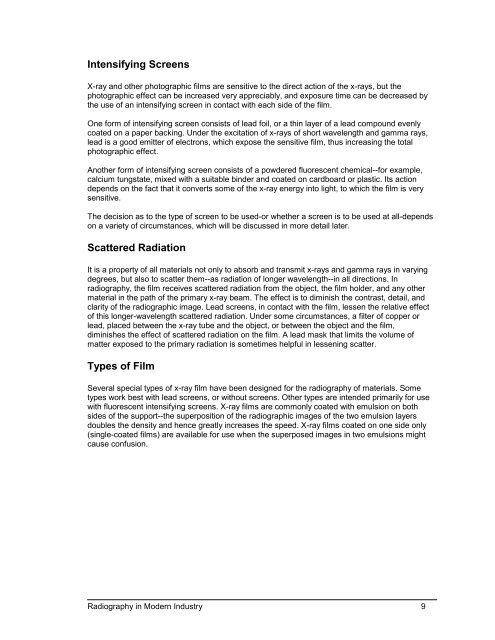Radiography in Modern Industry - Kodak
Radiography in Modern Industry - Kodak
Radiography in Modern Industry - Kodak
Create successful ePaper yourself
Turn your PDF publications into a flip-book with our unique Google optimized e-Paper software.
Intensify<strong>in</strong>g ScreensX-ray and other photographic films are sensitive to the direct action of the x-rays, but thephotographic effect can be <strong>in</strong>creased very appreciably, and exposure time can be decreased bythe use of an <strong>in</strong>tensify<strong>in</strong>g screen <strong>in</strong> contact with each side of the film.One form of <strong>in</strong>tensify<strong>in</strong>g screen consists of lead foil, or a th<strong>in</strong> layer of a lead compound evenlycoated on a paper back<strong>in</strong>g. Under the excitation of x-rays of short wavelength and gamma rays,lead is a good emitter of electrons, which expose the sensitive film, thus <strong>in</strong>creas<strong>in</strong>g the totalphotographic effect.Another form of <strong>in</strong>tensify<strong>in</strong>g screen consists of a powdered fluorescent chemical--for example,calcium tungstate, mixed with a suitable b<strong>in</strong>der and coated on cardboard or plastic. Its actiondepends on the fact that it converts some of the x-ray energy <strong>in</strong>to light, to which the film is verysensitive.The decision as to the type of screen to be used-or whether a screen is to be used at all-dependson a variety of circumstances, which will be discussed <strong>in</strong> more detail later.Scattered RadiationIt is a property of all materials not only to absorb and transmit x-rays and gamma rays <strong>in</strong> vary<strong>in</strong>gdegrees, but also to scatter them--as radiation of longer wavelength--<strong>in</strong> all directions. Inradiography, the film receives scattered radiation from the object, the film holder, and any othermaterial <strong>in</strong> the path of the primary x-ray beam. The effect is to dim<strong>in</strong>ish the contrast, detail, andclarity of the radiographic image. Lead screens, <strong>in</strong> contact with the film, lessen the relative effectof this longer-wavelength scattered radiation. Under some circumstances, a filter of copper orlead, placed between the x-ray tube and the object, or between the object and the film,dim<strong>in</strong>ishes the effect of scattered radiation on the film. A lead mask that limits the volume ofmatter exposed to the primary radiation is sometimes helpful <strong>in</strong> lessen<strong>in</strong>g scatter.Types of FilmSeveral special types of x-ray film have been designed for the radiography of materials. Sometypes work best with lead screens, or without screens. Other types are <strong>in</strong>tended primarily for usewith fluorescent <strong>in</strong>tensify<strong>in</strong>g screens. X-ray films are commonly coated with emulsion on bothsides of the support--the superposition of the radiographic images of the two emulsion layersdoubles the density and hence greatly <strong>in</strong>creases the speed. X-ray films coated on one side only(s<strong>in</strong>gle-coated films) are available for use when the superposed images <strong>in</strong> two emulsions mightcause confusion.<strong>Radiography</strong> <strong>in</strong> <strong>Modern</strong> <strong>Industry</strong> 9
















